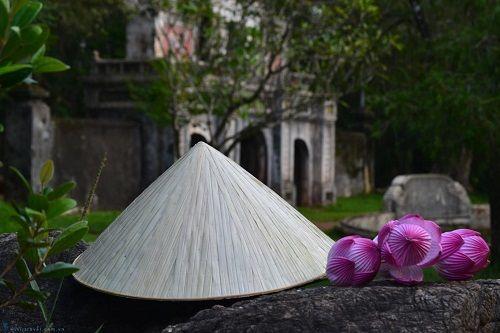Ho Tay is the largest of all the lakes in Ha Noi. The lake is on the northwest part of the city. Long ago, the lake was a branch of the Red river but later, as the river changed course, the lake remained a body of water just west of the river. There are many legends associated with West Lake. The most popular is the legend of the golden buffalo.
As the story goes, there once was a medicine man who was a giant. He is well known in Vietnam for his medicine practice and the king often used him to treat the royal family. His fame reached China and he was invited to China to treat the king. He was successful where others have failed so the king was going to reward him with great wealth. He refused offerings of gold and only requested that the king give him all the black copper in the king’s vault. The king agreed and the giant left for Vietnam with vast amounts of black copper. In Vietnam the giant molded a giant bell of black copper. The giant rang the bell and the sound resonated all the way to China. In the king’s vault there was a golden buffalo. Upon hearing the sound of the bell, the buffalo came to life (because he thought that his mother was calling him) and charged southward. Upon reaching Ha Noi, the buffalo trampled the land in the area near Red river. Over the years, this area filled with water and became Ho Tay or West Lake.
Ho Tay has always been an area for vacationing royalties. When Ha Noi was still the capital city, the kings from the Ly and Tran dynasty built summer homes along the lake. In the north end of the lake there are several villages famous for their flowers and fruits plantations. Most famous is Nghi Tam village, the birth place of Ba Huyen Thanh Quan, one of Vietnam’s premier Poetess.
Today, many of the summer homes built by kings of yesteryears are now shrines and temples. Phu Tay Ho is one of the more popular shrine on the shore of Ho Tay. During the first and fifteenth day of the lunar month, people from all over Ha Noi pour to the shrine to pay respect to the deities. On these days, the roads are filled with people dressed in colorful attire heading to the narrow road leading to the shrine. Phu Tay Ho is also famous for the Bun Oc (escargot vermicelli soup) and Banh Tom (shrimp cakes) sold in stalls along the way.
Tran Quoc Pagoda
Tran Quoc Pagoda is the oldest of all pagodas in Hanoi. Located beside the dazzling West Lake in Hanoi, Tran Quoc Pagoda is a cultural symbol of Vietnamese Buddhism. It is said that, the pagoda was built under the reign of King Ly Nam De (544-548) under its original name of Khai Quoc (National Founder). It was originally built on the bank of the Red River (then West Lake and the Red River met). In the time of King Le Kinh Tong (1600-1618), the pagoda was removed to the Kim Ngu (Golden Fish) Islet due to the river bank crumbling and was renamed Tran Quoc (National Defence). Unlike other ordinary pagodas, the Tran Quoc Pagoda was built intriBehind the worshipping shrine is the Buddhist trinity followed by corridors, ten shrines and the belfry. In the pagoda, there are many valuable statues, such as the red lacstatue trimmed with gold of Sakyamouni Buddha’s Parinirvana and many ancient stele, with the old- one made in 1639 by Doctoral lau- Nguyen Xuan Chinh recording the Pagoda’s history. In 1959, on his visit to Vietnam, Indian Prime Minister Razendia Prasat offered the Pagoda a bodhi tree as a gift. The plant was grafted from the holy bodhi tree where Sakyamuni sat in zen (meditation) position 25 centuries ago. Now the bodhi tree is green and luxuriant, shading part of the pagoda’s yard. As a religious relic among spectacscenery, Tran Quoc Pagoda is a favourite stop-over of many foreign visitors and pilgrims.
Quan Thanh Temple
Quan Thanh Temple is an important historical and cultural relic in Quan Thanh ward, Ba Dinh precinct, Hanoi. It was built during the reign of King Ly Thai To (1010-1028). The temple was dedicated to Huyen Thien Tran Vo, or the God who guarded and administered the north of the country. That is why it is also known as the Tran Vo Temple or the Temple of Quan Thanh Tran Vo.Situated on a large and beautiful area by West Lake near the northern gate of old Thang Long capital, Quan Thanh Temple is one of the Four Guards of Old Thang Long.The existing constructions originate from the last renovations that were made in the 19th century; these renovations included The triple gate, the yard, the front and central worshipping chambers, and the shrine. A bronze statue, nearly 4 m in height and 4 tons in weight, was cast in 1677 and dedicated to the holy Huyen Thien Tran Vo.














